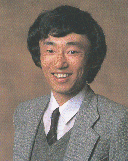
Hiroshi Shimodaira
Associcate Professor
e-mail: sim@jaist.ac.jp
Selected Publications
"Recognition of Devanagari Characters Using Neural Networks", IEICE Trans. Inf. & Syst., Vol.E79-D, No.5, pp.523-528 (1996-05)
``Automatic Prosodic Segmentation by F0 Clustering Using Superpositional Modeling'', Proc. of ICASSP-95, pp.624-627, 1995.
``Prosodic Phrase Segmentation by Pitch Pattern Clustering'', Proc. of ICASSP-94, 76.5, pp.217-220, 1994.
``A Fast VQ Codebook Design Algorithm for a Large Number of Data'', Proc. of ICASSP-92, I-109, 1992.
``Speaker-Independent Vowel-Sequence Recognition Based on a Binary Relational Model of Vowels'', Trans. of IEICE, J71-A, pp.1515-1522, 1988-08 (in Japanese).
Research Project Available
Speaker-independent speech recognition and speech understanding
Handwritten Chinese character recognition
Man-machine interface design
Speech recognition:
There are four research subjects I have been concerned with in order to develop a novel speech understanding system (SUS). One is to solve the between-speaker variability problem which is one of the most important, and still very difficult, obstacles for realizing a speaker-independent SUS. Our research group is trying to model speaker variations both in static and dynamic domains, i.e. spectral and temporal domains. The second one is to develop a technique of incorporating prosodic features into SUS. Prosodic features, such as accent, intonation and pauses, are noticed as super segmental features of spoken language, and provide important information for comprehending speech. Although these features have not been used successfully in SUS because of their unreliable and unstable properties, we expect that stochastic analysis of the prosodic features and optimal search algorithms will enable us to make use of the features for SUS. The two remaining subjects are to study man-machine interface, and to develop efficient algorithms for optimization problems useful to pattern recognition.
Character recognition:
Automatic recognition of handwritten Chinese characters still remains a very difficult task in spite of intensive research over 10 years. One of the main reasons is the various differences in character images drawn by different writers. We have been studying several kinds of pattern transformation methods to overcome this obstacle. In addition, we have been developing an easy-to-use character-to-braille translation system for blind readers.
